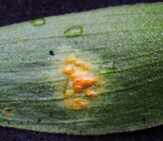I have been sampling the tasty purple berries of Dianella revoluta/ Blueberry lily. It is bush tucker with an edible fleshy berry containing two small nutty seeds. Dianellas are called flax lilies (Noongar name is Mangard) because fibre from the stiff linear leaves makes a handy string or cord for binding. Noongars also crushed and ate the rhizomes.
When I googled Dianella plant I was surprised to see that nurseries have produced new cultivars for the garden.
- Stypandra glauca/Blind grass is a member of the grass lily genus with a similar looking flower. However, it is a toxic to introduced grazing animals, and the fruit is a dry capsule rather than a berry.
- Agrostocrinum scabrum/ Blue grass lily occcurs on gravels.It has a deep blue flower and a dry capsule rather than a berry
- Dichopogon callipes is an early summer flowering plant with a few small straight leaves on the stem and delicate blue flowers. It is normally inconspicuous, but a delight to see in mornings when the sun is behind it.
No doubt forests have been felled for journal articles and careers have waxed and waned during the lily wars. I assume that microscopes and DNA analysis are the main weapons as plants do not possess anal hairs. I digress.
From a layman’s view they are all monocotyledons (generally 3 petals, 3 sepals) with rhizomes and/or root tubers. All three plants are resprouters that can recover from fires using energy reserves stored in their roots.
Agrostocrinum, Dianella and Stypandra are in the Hemerocallidaceae family with other Foxes Lair genera Caesia,and Tricoryne.
Dichopogon is in the large Asparagaceae family, which includes all our orchids and (you guessed it) asparagus.
 Rampant bridal creeper at Manaring spring
Rampant bridal creeper at Manaring spring It is an aggressive competitor due to
- A climbing and spreading growth habit
- Profuse berry production. I frequently find small bridal creeper plants at the base of trees in the bush, that have germinated from seeds that passed through birds.
- A huge ability to recover from adversity using root reserves. 90% of the plant occurs underground as a mat of rhizomes and root tubers. Control by cultivation and pulling has no effect.
This year I thought I would kill some plants in the arboretum using two applications of a glyphosate and metsulfuron.
Images below show that sprayed plants had more shrivelled old (brown) root tubers but survived, and produced (less) new season tubers and set seed.
 Bridal creeper leaf rust
Bridal creeper leaf rust Unfortunately, Narrogin’s climate is too dry for the introduced bridal creeper rust to persist, and introduced mites are unlikely to have much impact on plants dispersed in the bush. It is going to be a long battle.








